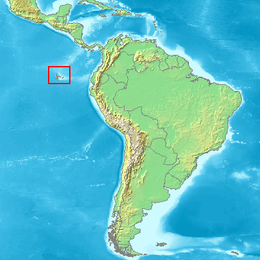Isabela Island (Galápagos)
| Native name: Isabela | |
|---|---|

Map of Galápagos Islands
|
|
 |
|
| Geography | |
| Location | Pacific Ocean |
| Coordinates | 00°30′S 91°04′W / 0.500°S 91.067°WCoordinates: 00°30′S 91°04′W / 0.500°S 91.067°W |
| Archipelago | Galápagos Islands |
| Area | 4,640 km2 (1,790 sq mi) |
| Length | 100 km (60 mi) |
| Highest elevation | 1,707 m (5,600 ft) |
| Highest point | Volcán Wolf |
| Administration | |
|
Ecuador
|
|
| Province | Galápagos Province |
| Demographics | |
| Population | 1,748 |
| Pop. density | 0.47 /km2 (1.22 /sq mi) |
| Ethnic groups | Ecuadorians |
Isabela Island (Spanish pronunciation: [isaˈβela]) is the largest island of the Galápagos with an area of 4,640 square kilometres (1,790 sq mi) and length of 100 kilometres (62 mi) almost four times larger than Santa Cruz, the second largest of the archipelago. It was named after Queen Isabella of Spain. It was originally named Albemarle after the Duke of Albemarle. The island strides the equator.
One of the youngest islands, Isabela is located on the western edge of the archipelago near the Galápagos hotspot. At approximately 1 million years old, the island was formed by the merger of 6 shield volcanoes - Alcedo, Cerro Azul, Darwin, Ecuador, Sierra Negra, and Wolf. All of these volcanoes except Ecuador are still active, making it one of the most volcanically active places on earth. Two of the volcanoes, Volcan Ecuador and Volcan Wolf (the island's highest point with an elevation of 1,707 m [5,600 ft]), lie directly on the equator. The island is primarily noted for its geology, providing excellent examples of a geologic occurrence that created the Galápagos Islands including uplifts at Urvina Bay and the Bolivar Channel, tuff cones at Tagus Cove, and Pulmace on Alcedo and Sierra Negra, one of the most active volcanoes in the world.
Isabela is also interesting for its flora and fauna. The young island does not follow the vegetation zones of the other islands. The relatively new lava fields and surrounding soils have not developed the sufficient nutrients required to support the varied life zones found on other islands. Another obvious difference occurs on Volcan Wolf and Cerro Azul; these volcanoes loft above the cloud cover and are arid on top.
...
Wikipedia
